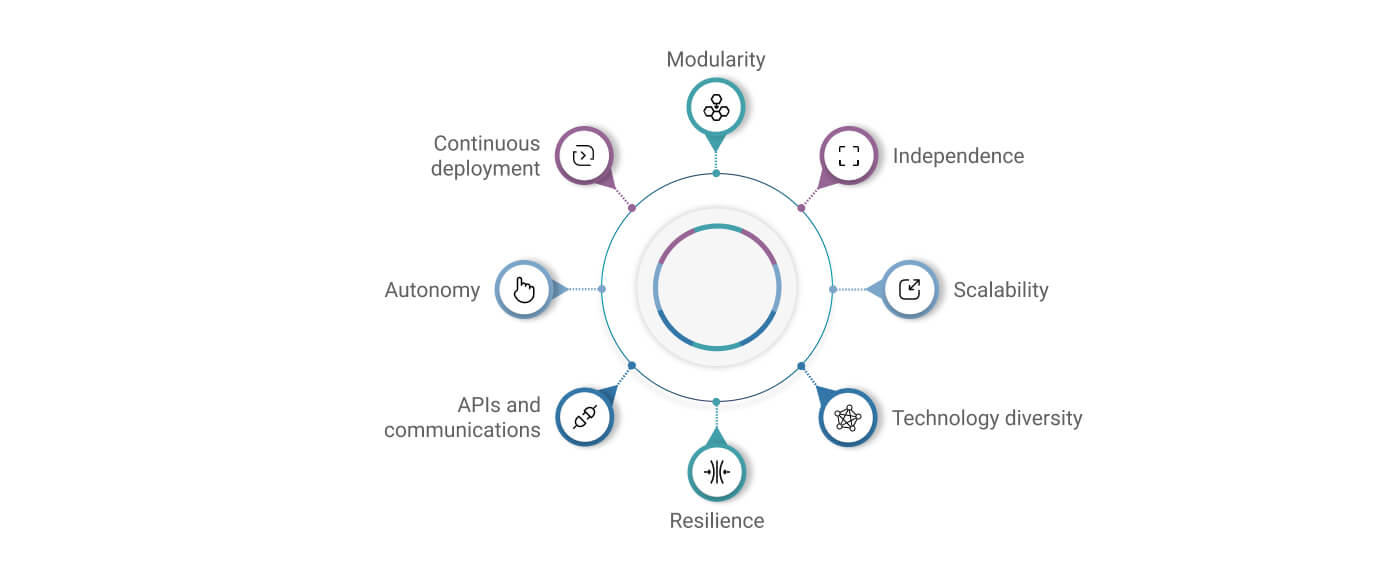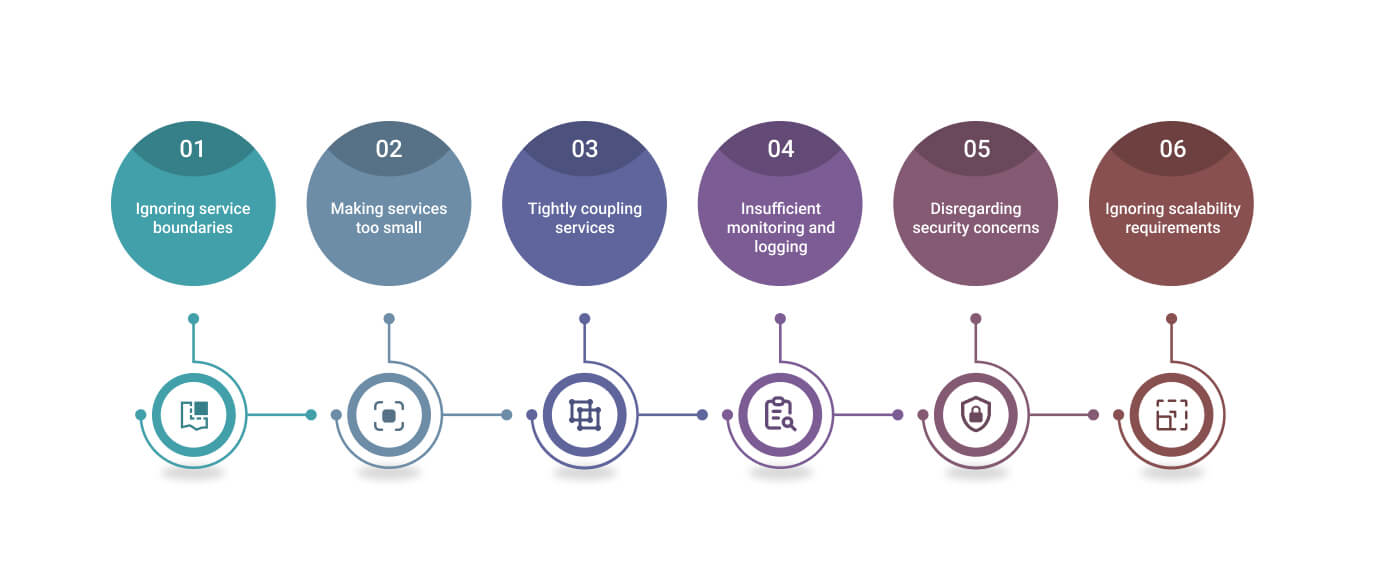 By Jophin
January 4, 2024
3 min read
By Jophin
January 4, 2024
3 min read
Common mistakes to avoid when designing Microservices applications
Most Singaporean startups and business owners might have heard about Microservices architecture. This architecture brings valuable benefits to the table when scaling an application or implementing new-fangled functionalities or attributes in products. Several startups and organizations prefer Microservices over monolithic for scaling due to the demerits of monolithic architecture.
Generally, monolithic architecture applications are tightly coupled. Besides, it will be hard to maintain and scale individual components separately for developers. As a result, it can lead to performance bottlenecks and slow response times in your application or product. That is why business owners in Singapore choose Microservices for scaling and building complex web applications.
The adoption of microservices has become a prevalent trend. While microservices offer benefits like scalability, flexibility, and faster development, designing and implementing a microservices architecture comes with its own set of pitfalls. On the flip side, developers and startups are making a few common mistakes when designing or scaling Microservice apps.
In this blog post, we will discuss what microservice applications are, and explore six common mistakes to avoid when designing microservices apps. This blog might be helpful for your developers and architects who desire to navigate the complexities of this architectural style.
What are Microservices applications?
Microservices applications, also known as microservices architecture. It is an approach to developing or scaling applications as a collection of small, independent services that communicate with each other through APIs. Each microservice focuses on a specific business capability and can be created, launched, and scaled independently. This modular structure allows for easier maintenance, updates, and adaptability to evolving business requirements. Here we list a few key characteristics and principles that define microservices applications.

Despite these advantages, it’s essential to note that adopting microservices also holds a set of challenges, such as increased complexity in managing distributed systems, potential data consistency issues, and the need for robust monitoring and governance.
Microservices applications primarily aim to replace monolithic architectures with a more decentralized and agile model. The advantages include improved fault isolation, better resource utilization, and the ability to use different programming languages and frameworks for different services. However, the transition from monolithic to microservices architecture requires careful planning to avoid common pitfalls.
Now, it’s time to explore the common mistakes that startups or developers need to avoid when designing microservices architecture.
6 mistakes to avoid when designing Microservices applications
Microservices architecture offers a flexible approach to product development, but its successful implementation requires careful consideration of various factors. Here are six common mistakes to avoid when designing microservices applications.

-
Ignoring service boundaries
Ignoring service boundaries is a significant pitfall when designing microservices applications. One of the fundamental principles of microservices is the clear definition of service boundaries. Each microservice should have a well-defined scope and responsibility, which focuses on a specific business capability. Ignoring this principle can lead to a tangled web of dependencies between services.
As a result, it makes the system difficult to understand, maintain, and scale. Therefore, careful consideration should be given to describing business domains for each service, which ensures a clean separation of concerns.
-
Making services too small
When creating a microservices application, most developers frequently make the fatal mistake of making each microservice sufficiently small that the entire app requires several microservices.
Developers make this mistake as they think that smaller is better when it comes to microservices. Each microservice should provide tangible business value and not be overly fragmented. Services that are too small may lead to increased overhead in terms of communication and coordination between services. Striking the right balance between quality and functionality is essential to avoid the pitfalls of services that are either too large or small.
-
Tightly coupling services
It is one of the major mistakes made by most product developers in the marketplace. Tight coupling between microservices undermines the independence and autonomy that defines microservices architecture. When services are tightly coupled, changes in one service may have a cascading effect on others, which leads to unintended consequences and increased development overhead.
To mitigate this mistake, it is crucial to design services with loose coupling in mind, by using well-structured APIs and communication protocols to enable each service to evolve independently.
-
Insufficient monitoring and logging
Microservices applications involve numerous independently deployable services. Without adequate monitoring and logging, identifying and troubleshooting issues becomes a daunting task. Furthermore, insufficient visibility into the system’s behavior can lead to prolonged downtime and negatively impact user experience.
In addition, implementing comprehensive monitoring and logging practices is essential for detecting, diagnosing, and resolving issues promptly. This includes monitoring service health, tracking performance metrics, and logging relevant events for effective debugging.
-
Disregarding security concerns
Security is a critical aspect of any business application, and microservices are no exception. Disregarding security concerns, such as insufficient authentication and authorization mechanisms, can expose vulnerabilities across the microservices ecosystem.
Each microservice must implement proper security measures, including secure communication channels, access controls, and data encryption. The entire system should enforce consistent security policies to protect against potential threats.
-
Ignoring scalability requirements
As you know, Microservices architecture is well-known for its scalability. Ignoring scalability requirements during the design phase can lead to suboptimal performance and resource utilization. Each microservice should be designed with scalability, considering factors like load balancing, horizontal scaling, and the ability to handle varying workloads.
Failure to address scalability requirements may result in service outages or increased infrastructure costs. A proactive approach to designing for scalability ensures that the microservices application can efficiently adapt to changing demands.
By avoiding these six mistakes, your team of developers can design and build robust microservice applications based on your business needs.
Final thoughts
As a startup or business owner, designing microservices applications requires a strategic approach to overcome potential challenges. By avoiding common mistakes such as neglecting service boundaries, overlooking data management challenges, disregarding security concerns, and more, you can build robust and scalable microservices architectures.
Embracing best practices and continuous monitoring will contribute to the success of microservices projects. Also, it enables you to harness the full potential of this modern architectural paradigm. You are in the right place to effectively take your business to the next level if you are a Singaporean business owner with plans to develop microservice apps.
Fortunesoft is a pioneer in product engineering and a leading product development company in Singapore with 14+ years of experience in offering advanced technology solutions. We specialize in providing top-notch product creation and scaling services for Singapore enterprises, startups, and businesses of all sizes. Our core expertise lies in building superfine applications by leveraging the latest technology and cutting-edge AI-powered tools.
Author Bio


 Facebook
Facebook Whatsapp
Whatsapp LinkedIn
LinkedIn Pinterest
Pinterest Email
Email






 Start Chat
Start Chat